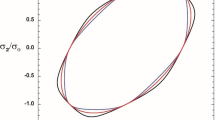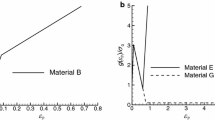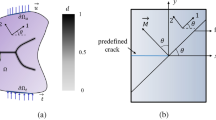Abstract
Plane stress mode I crack-tip fields for perfectly plastic orthotropic materials are studied. Plastic orthotropy is described by Hill's quadratic yield function. The construction of crack-tip fields is based on the general crack-tip field analysis for elastic perfectly plastic materials given by Rice [1] and guided by the corresponding low-hardening power-law solutions. Two very different types of plane-stress crack-tip fields emerge as plastic orthotropy is varied. The first one consists of a centered fan sector in front of the crack tip and two neighboring constant stress sectors. The second one consists of a constant stress sector in front of the crack tip, a constant stress sector bordering the crack face, and a centered fan sector between the two constant stress sectors. All the perfectly plastic crack-tip solutons are verified by the corresponding low-hardening power-law solutions. General trends of crack-tip stress solutions as functions of plastic orthotropy and implications of these solutions to the design of ductile composite materials are discussed.
Résumé
On étudie les champs de contraintes planes de mode I à l'extrémité d'une fissure, dans les matériaux orthotropiques parfaitement plastique. L'orthotropie plastique est décrite par la fonction quadratique de plasticité de Hill. On base les constructions des champs de constraintes sur l'analyse générale des constraintes à l'extrémité d'une fissure fournie par Rice pour les matériaux élastiques parfaitement plastiques, que l'on règle par les lois paraboliques caractérisant un faible écrouissage. Lorsque l'on modifie l'orthotropie plastique, il apparaît deux types de champs de contraintes à l'extrémité de la fissure très différents. Le premier comporte un secteur en éventail centré sur le front de fissure, et deux secteurs voisins à contraintes constantes. Le second consiste en une secteur à contrainte au bord de la surface de la fissure, et un secteur en éventail centré sur les deux secteurs à contraintes constantes. Toutes les solutions relatives à une extrémité de fissures parfaitement plastique sont vérifiées par les fonctions paraboliques d'écrouissage faible correspondantes. On discute des tendances générales que suivent les solutions pour les contraintes en extrémité de fissure selon l'orthrotropie plastique, et des implications que comportent ces solutions dans la conception de matériaux composites ductiles.
Similar content being viewed by others
References
J.R. Rice, in Mechanics of Solids: The R. Hill 60th Anniversary Volume, H.G. Hopkins and M.J. Sewell (eds.), Pergamon Press, Oxford (1982) 539–562.
R. Hill, The Mathematical Theory of Plasticity, Oxford University Press, London (1950).
R. Hill, Proceedings Royal Society of London, Series A 193 (1948) 281–291.
R. Hill, Mathematical Proceedings Cambridge Philosophical Society 85 (1979) 179–191.
J.W. Hutchinson, Journal of the Mechanics and Physics of Solids 16 (1968) 13–31.
J.W. Hutchinson, Journal of the Mechanics and Physics of Solids 16 (1968) 337–347.
J.R. Rice, Transaction of the ASME, Journal of Applied Mechanics 35 (1968) 379–386.
J.R. Rice and G.F. Rosengren, Journal of the Mechanics and Physics of Solids 16 (1968) 1–12.
C.F. Shih, “Elastic-Plastic Analysis of Combined Mode Crack Problems,” Ph.D. thesis, Harvard University, Cambridge, Mass. (1973).
C.F. Shih, in Fracture Analysis, ASTM STP 560 (1974) 187–210.
C.F. Shih, “Tables of Hutchinson-Rice-Rosengren Singular Field Quantities,” MRL E-147, Material Research Laboratory, Brown University (1983).
S. Nemat-Nasser and M. Obata, Mechanics of Materials 3 (1984) 235–247.
K. Hayashi, Journal of the Mechanics and Physics of Solids 27 (1979) 163–174.
J. Pan and C.F. Shih, Mechanics of Materials 5 (1986) 299–316.
J. Pan and C.F. Shih, International Journal of Fracture 37 (1988) 171–195.
J. Pan, Journal of the Mechanics and Physics of Solids 34 (1986) 617–635.
J.R. Rice, Journal of the Mechanics and Physics of Solids 21 (1973) 63–74.
J.R. Rice, in Fracture, Vol. 2, H. Liebowitz (ed.), Academic Press, New York (1968) 191–311.
N. Levy, P.V. Marcal, W.J. Ostergren, and J.R. Rice, International Journal of Fracture Mechanics 7 (1971) 143–156.
J.R. Rice and D.M. Tracey, in Numerical and Computer Methods in Structural Mechanics, S.J. Fenves et al. (eds.), Academic Press, New York (1973).
D.M. Tracey, Journal of Engineering Materials and Technology 98 (1976) 146–151.
D.M. Parks, “Some Problems in Elastic-Plastic Finite Element Analysis of Cracks,” Ph.D. thesis, Brown University, Providence, RI (1975).
J.R. Rice, Mechanics of Materials 3 (1984) 55–80.
J.R. Rice and R. Nikolic, Journal of the Mechanics and Physics of Solids 33 (1985) 595–622.
J.R. Rice, “Tensile Crack Tip Fields in Elastic-Ideally Plastic Crystals,” Report No. Mech-106, Division of Applied Sciences, Harvard University (July 1987) to be published.
Author information
Authors and Affiliations
Rights and permissions
About this article
Cite this article
Pan, J. Plane-stress crack-tip fields for perfectly plastic orthotropic materials. Int J Fract 38, 103–122 (1988). https://doi.org/10.1007/BF00033001
Received:
Accepted:
Issue Date:
DOI: https://doi.org/10.1007/BF00033001




